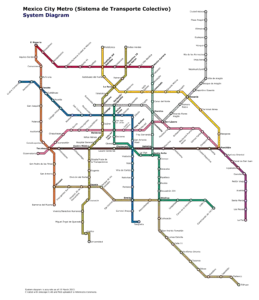Podcast: Play in new window | Download
Subscribe: Apple Podcasts | RSS
 No one knows just how many people live in the gigantic metropolitan area of Mexico City. Some demographers say 18 million. Some say 20 million. Others even say up to 25 million people live there. The subway or metro that serves this megalopolis plays a vital role in moving people around. Since its opening in 1969, the metro system has expanded to 12 lines, and it now has 195 stations and over 140 miles of track. The metro transports some 4 million passengers per day. For a mere 5 pesos, a little over twenty-five cents US, you can go practically anywhere. Mexican journalist and cultural critic Carlos Monsiváis Aceves once wrote about the Mexico City subway system, “it is a space for collective expression, where diverse social sectors are compelled to mingle every day.” Apparently, it is also a fertile ground for ghost stories and many urban legends. Here are six.
No one knows just how many people live in the gigantic metropolitan area of Mexico City. Some demographers say 18 million. Some say 20 million. Others even say up to 25 million people live there. The subway or metro that serves this megalopolis plays a vital role in moving people around. Since its opening in 1969, the metro system has expanded to 12 lines, and it now has 195 stations and over 140 miles of track. The metro transports some 4 million passengers per day. For a mere 5 pesos, a little over twenty-five cents US, you can go practically anywhere. Mexican journalist and cultural critic Carlos Monsiváis Aceves once wrote about the Mexico City subway system, “it is a space for collective expression, where diverse social sectors are compelled to mingle every day.” Apparently, it is also a fertile ground for ghost stories and many urban legends. Here are six.
The Ghostly Little Girl with the Red Ball
 Metro Line 5, the Yellow Line, stops at Benito Juárez International Airport at a station appropriately called Terminal Aérea. Mexico City’s main airport is the busiest airport in all Latin America and the Yellow Line provides a vital transportation link to rest of the city. The Terminal Aérea metro station sees tens of thousands of passengers per day. Some of these passengers have reported seeing the same paranormal sight. The story has very little variation. A young girl, elementary school age, is playing with a red ball. She loses control over the ball and it bounces to the unsuspecting “experiencer.” The person picks up the ball to hand it to the little girl at which point the little girl asks the stranger to tie her shoe. When the person bends over to tie her shoe, that person sees the legs of the little girl disappear and then the rest of her body vanishes. In some variations of the story, the girl growls and her eyes turn black before she disappears, as if she is possessed or is overtaken by an evil force. In one version of the story the ball the little girl plays with is the actual head of the little girl and when the helpful stranger catches it, they will drop it in horror. The girl is long gone by then, of course.
Metro Line 5, the Yellow Line, stops at Benito Juárez International Airport at a station appropriately called Terminal Aérea. Mexico City’s main airport is the busiest airport in all Latin America and the Yellow Line provides a vital transportation link to rest of the city. The Terminal Aérea metro station sees tens of thousands of passengers per day. Some of these passengers have reported seeing the same paranormal sight. The story has very little variation. A young girl, elementary school age, is playing with a red ball. She loses control over the ball and it bounces to the unsuspecting “experiencer.” The person picks up the ball to hand it to the little girl at which point the little girl asks the stranger to tie her shoe. When the person bends over to tie her shoe, that person sees the legs of the little girl disappear and then the rest of her body vanishes. In some variations of the story, the girl growls and her eyes turn black before she disappears, as if she is possessed or is overtaken by an evil force. In one version of the story the ball the little girl plays with is the actual head of the little girl and when the helpful stranger catches it, they will drop it in horror. The girl is long gone by then, of course.
The Gigantic Rats and Rat-Like Creatures in the Tunnels of Metro Line 3
 The Olive-colored Metro Line 3 is the longest line in the whole Mexico City subway network. It runs north to south from the Indios Verdes Station to Universidad. A small northern tunnel section of this line draws a lot of attention from curiosity seekers who have heard strange stories of unusual creatures spotted between the Tlatelolco and La Raza stations. According to urban legends and some eyewitness accounts, rats as large as dogs roam the tracks and have even attacked people. As early as the late 1970s, rumors spread of a rat the size of a pig that came out from the darkness of the tunnel and killed a young girl while she was waiting for a train on the metro platform with her parents. Transit workers and commuters alike have also reported seeing a hunched over deformed humanoid figure covered in fur lurking around the tracks in the semi-darkness of the tunnels near the Tlatelolco Station. Further south along this same line, Metro Line 3, a similar creature has been spotted in the tunnels near the Viveros Station. Commuters have dubbed this creature the “Rat Man.” From the Viveros Station south through the tunnels to the next stop, Miguel Ángel de Quevedo, metro passengers have reported hearing shrill shrieking sounds which are attributed to this Rat Man. Are reports of this creature just simply misidentified transients or vagrants living in the tunnels, or does the Mexico City subway system really have a gigantic gigantic rat problem?
The Olive-colored Metro Line 3 is the longest line in the whole Mexico City subway network. It runs north to south from the Indios Verdes Station to Universidad. A small northern tunnel section of this line draws a lot of attention from curiosity seekers who have heard strange stories of unusual creatures spotted between the Tlatelolco and La Raza stations. According to urban legends and some eyewitness accounts, rats as large as dogs roam the tracks and have even attacked people. As early as the late 1970s, rumors spread of a rat the size of a pig that came out from the darkness of the tunnel and killed a young girl while she was waiting for a train on the metro platform with her parents. Transit workers and commuters alike have also reported seeing a hunched over deformed humanoid figure covered in fur lurking around the tracks in the semi-darkness of the tunnels near the Tlatelolco Station. Further south along this same line, Metro Line 3, a similar creature has been spotted in the tunnels near the Viveros Station. Commuters have dubbed this creature the “Rat Man.” From the Viveros Station south through the tunnels to the next stop, Miguel Ángel de Quevedo, metro passengers have reported hearing shrill shrieking sounds which are attributed to this Rat Man. Are reports of this creature just simply misidentified transients or vagrants living in the tunnels, or does the Mexico City subway system really have a gigantic gigantic rat problem?
The Friendly Apparition of a Loyal Transit Worker
The setting for this story is the Pino Suárez Station at the junction of the pink line and the blue line or Lines 1 and 2 of the Mexico City subway system. The station is well known because it features a partly unearthed section of an ancient pyramid dedicated to the Aztec god of wind, Ehecatl built sometime in the 1490s. This temple was discovered during the station’s construction in the late 1960s. The station is also well known for a strange story that seems to repeat itself every few years. The last telling of this story happened only a few years ago. After the last train departed for the night, a worker in charge of checking out the tracks at the station ran into a metro employee who was doing something similar. This confused the worker to see someone else doing his job and he thought that this other person checking the tracks was probably new and reported for work in the wrong place. So, the worker confronted the person. The stranger said that it was also his job to check the tracks after the last train had left the station. The transit worker took a picture of the man on his cell phone and showed it to his supervisor. The shocked supervisor recognized the man in the cell phone photo: He was a metro worker who had died many years ago, killed by a runaway train while he was inspecting the tracks. Transit employees who spend time on the tracks are supposed to stand toward the direction of oncoming traffic. The inspector who died had switched directions and didn’t have time to respond to the runaway train that hit him from behind. The supervisor asked around to some of the old timers and they, too, remember seeing the friendly apparition of the worker still doing his job decades after an accident took his life.
The Vampire and the Man Who Fell Asleep on the Train
This scary tale takes place at the last metro station on Line 7, the orange line. The end of the line stop is called Barranca del Muerto, which translated into English means, “ravine” or “gully” “of the Dead.” This station bears this name because it was built near the site of a mass grave, a trench filled with the bodies of soldiers killed during the Mexican Revolution in the early part of the 20th Century. It’s only fitting that the area would be full of unsettled spirits. The famous legend involving Barranca del Muerto begins when the metro ends, in the wee hours of the morning when all the trains stop. A man who fell asleep on the train suddenly woke up to find that he was alone in the train car and the train was parked in a tunnel for the night. He got out of the train and onto the tracks where he spotted two men fighting in the tunnel. One was taller than the other and it looked like he was killing the shorter man. The man who fell asleep went over to the two men to try to break up the fight and that is when he noticed that the taller man was biting the neck of the other man which was bleeding profusely. The man screamed, “Vampire!” and ran as fast as he could to the nearest police station. There, he was met with ridicule when he told his story to the authorities. Some say that this legend is based on a true story and that the person was just witnessing a really bad drunken fight. The biting was not from a vampire but from a person who was just temporarily out of sorts. Others say that this story was concocted to scare younger people into paying attention while they are on the train. It would be rather easy for a commuting teenage student to fall asleep while taking a late-night train. Perhaps thoughts of vampires have kept many a Mexico City commuter upright and awake even on the last trains of the day.
 The Witch of Garibaldi Station
The Witch of Garibaldi Station
The gray line meets the green line at the green line’s northern terminus at a station called Garibaldi. The station is named for Plaza Garibaldi, an important landmark nearby named after Giuseppe Garibaldi the Second, a soldier in the Mexican Revolution serving under Francisco Madero. There is nothing spectacular about this station, but it does get very busy as a major transfer point between lines. Since the station opened in 1994, hundreds of commuters and transit workers have reported seeing a floating woman wearing all black, including a black veil. Sometimes she appears only in silhouette form and seems to glide gracefully over the platform and the tracks, not making a sound. Sometimes her appearance is scarier and more hideous. Beneath the veil is the face of a haggard old woman with a sour countenance, intending to do harm or cause a commotion. She is said to go after unattended children to take back to her lair located somewhere within the depths of the subway tunnels, so parents beware. Some believe that the apparition is not a witch but the ghost of a minor Spanish noblewoman whose family owned the land surrounding the metro station during colonial times. She was unfaithful to her husband or committed some other transgression when she was alive, so now she is condemned to haunt the Garibaldi Station. Ghost or witch? You decide.
The Ancient Aztec Ghost
Traveling through the heart of Mexico City the blue line cuts through what 500 years ago would have been the center of the ancient Aztec capital of Tenochtitlán. On this line, strange apparitions have appeared before transit workers and travelers at both the Pino Suárez and Zócalo stations, and the tunnels going to and from these stations. The most common apparition is that of an ancient Aztec man. There are many variations to this sighting which may indicate separate ghostly beings or perhaps just poorly observed phenomena. In all stories the apparition is always male,  and he is always dressed in indigenous clothing from pre-Conquest times. In many versions of the story, the man is crying, perhaps longing for a time and a city that once was. In quite a few iterations of this tale, the man interacts with people of this world in a friendly way, and even speaks to them. Though the Aztec empire ended five centuries ago, the imperial language, Nahuatl, not only survived the Conquest, it has thrived in modern times. The second most widely spoken indigenous language in the Americas behind the Inca language, Quechua, Nahuatl boasts over a million speakers in central Mexico in these first decades of the 21st Century. The Aztec ghost in the metro stations is supposedly speaking to modern-day people in his native language and these people are understanding him. In some stories he asks startled commuters what has happened and where he is, as if he is lost. In one version of the story he is dressed as a jaguar knight and is eager to rejoin his fellow warriors in the Aztec army to continue fighting some battle. In another version he is dressed in the common cactus fiber tilma of a humble peasant, sad at what his beautiful city has become and voicing his disappointment with the modern world. Some of these sightings have reached the local news media and have many Mexico City residents believing that these alleged Aztec ghosts are real spirits who are somehow trapped in our time, perhaps confused, and longing to return to the splendor of their ancient capital city.
and he is always dressed in indigenous clothing from pre-Conquest times. In many versions of the story, the man is crying, perhaps longing for a time and a city that once was. In quite a few iterations of this tale, the man interacts with people of this world in a friendly way, and even speaks to them. Though the Aztec empire ended five centuries ago, the imperial language, Nahuatl, not only survived the Conquest, it has thrived in modern times. The second most widely spoken indigenous language in the Americas behind the Inca language, Quechua, Nahuatl boasts over a million speakers in central Mexico in these first decades of the 21st Century. The Aztec ghost in the metro stations is supposedly speaking to modern-day people in his native language and these people are understanding him. In some stories he asks startled commuters what has happened and where he is, as if he is lost. In one version of the story he is dressed as a jaguar knight and is eager to rejoin his fellow warriors in the Aztec army to continue fighting some battle. In another version he is dressed in the common cactus fiber tilma of a humble peasant, sad at what his beautiful city has become and voicing his disappointment with the modern world. Some of these sightings have reached the local news media and have many Mexico City residents believing that these alleged Aztec ghosts are real spirits who are somehow trapped in our time, perhaps confused, and longing to return to the splendor of their ancient capital city.
The Mexico City subway system is home to seemingly endless miles of tunnels, almost 200 stations and plenty of tall tales. As with anything paranormal, one must ask, are these strange stories real, partly based on fact or complete fabrications? Perhaps a ride on the metro is in order. While among the multitudes of passengers, just be careful to watch out for the witches, the rats, the vampires and the many ghosts.
REFERENCES
Various Spanish-language pop culture and legends sites including: primeravoz, travelreport, maspormas and others.
